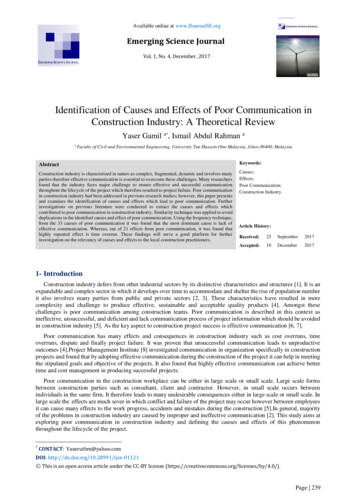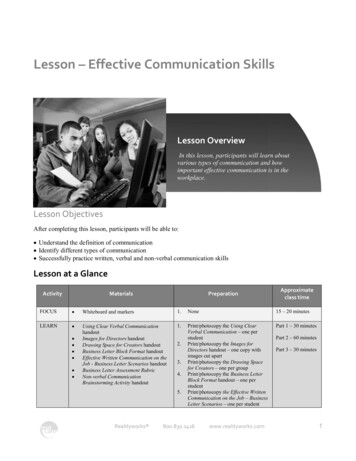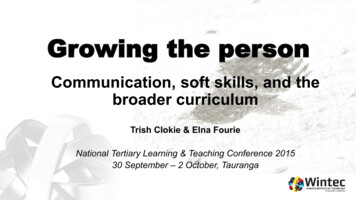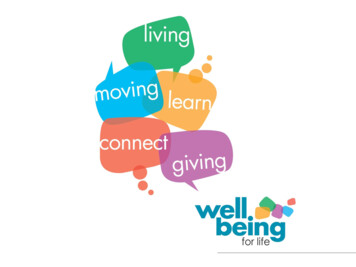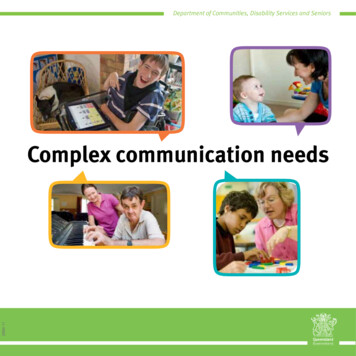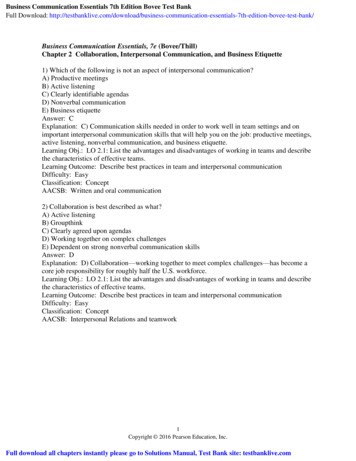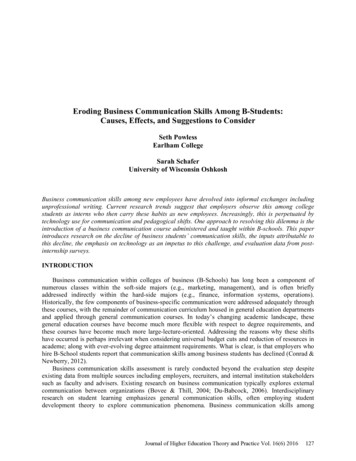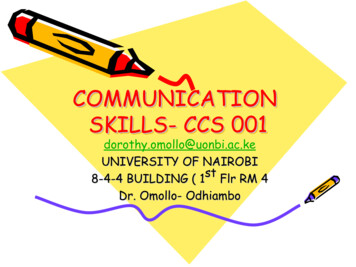
Transcription
COMMUNICATIONSKILLS- CCS 001dorothy.omollo@uonbi.ac.keUNIVERSITY OF NAIROBI8-4-4 BUILDING ( 1st Flr RM 4Dr. Omollo- Odhiambo
THIS LECTURE IS ABOUTTO BEGIN .IF YOU ARE IN POSSESSION OF ACELL PHONE, KINDLY TURN IT OFFNOW !
Who am I ?Dr D. Omollo- Odhiambo ( BED, M ED, Phd HealthCommunication- School of Journalism and MassCommmunication Lecturer, UON Dept of Communication Skills and StudiesDorothy.omollo @uonbi.ac.ke
AIM of COMM. SkillsUnit Aim is to equip students withcommunication skills suitable foracademic and career purposes: impartknowledge, attitudes and skills forUniversity academic pursuit.
OBJECTIVES By the end of the course, studentsshould be able to:- Communicate effectively foracademic purposes.- Apply requisite comm-skills.-Demonstrate understanding ofgeneric fundamentals ofcommunication.
Course schedule CCS-001- 4 SKILL AREAS Begins with Introduction toAcademic Communication Skills Academic Writing Skills, AcademicReading Skills, Public speaking andoral presentation skills, Functionalwriting skills,
Course Evaluation CATS in each given skill area Final summative examination for two hours in allskills taught Class participation and expectation that eachstudent will have to exhibit mastery andknowledge of each communication skill area. Contact hours is 45 hrs including two hrs exam COURSE will be taught through Lectures, Groupdiscussions and individual student presentations
RecommendedReadings/BooksAfoloyan, A & Newsum, H.E ( I986)The Use of English CommmunicationSkills for University Students.London: LongmanComprehensive reading list in theCourse outline
Importance ofCommunication Comm-skills not just handy; they arecritical tools for success Important for survival in real worldenvironment, Critical for propagation of kldge anddevelopment; Managing change/conflicts effectively,
Importance ofCommunication Comm-skills are the building blocksof academic life and career, Comm-skills occupies central positionin a students’ life and that ofpracticing professional; Basic skills for survival at university,higher learning.
Importance ofCommunication Useful in training of professionalsand acquisition of:-Cognitive skills- Psychomotor-(Technical) skills-Social –( Comm. skills)All professionals need more thanspecialized kldge
Introduction What is communication?In simple words we can say that““just to convey the message”If we go in more detail we can say that“ communication is the process oftransmitting (AB) & Receiving(BA) Messages.
Communication Defined Theodorson ( 1969): Defines comm. as thetransmission of information , ideas, attitudes, oremotions from one person or group to another orothers primarily through symbols Osgood et al. (1957) There is communicationwherever one system or source influencesanother, by manipulation of alternative symbolstransmitted over the channel
Communication Defined Gerber ( 1957) defines communication as socialinteraction through messages. Comprehensive: Communication is the process oftransmitting information and messages from onepoint to another for the purpose of elicitingaction actions that will accomplish a specific goal. Communication is done with the intention ofinfluencing an audience As a process, communication is not discrete,static or solitary. It exists in time and changesconstantly
Organizational Comm. Process by which info is passedbetween individuals, groups or deptsand externally to customers, clients,suppliers, and other stakeholders bymeans of previously agreed symbolsfor purposes of eliciting appropriateaction to enhance orgs image,efficiency and effectiveness.
Effective Communication: If some one achieve the desiredlevel of objective throughcommunication , we can say that it is“effective communication”.e.g. If your communication get theproper response from the receiver itmeans that you effectively conveyedthe message.
How to achieve effectiveCommunicationEncourage creative and Critical ThinkingConsider audience’s information needsConsider Audience's Technical BackgroundConsider Audience's Cultural Background andGenderConsider Audience's Knowledge of theSubject
What is effective communication?
Consider the possibility ofCommunication FailureExpect audience resistanceRecognize communication constraintsLegal, social economic,psychological, institutional,cultural etc
Using gender-neutral terms for occupations, positions, roles,Terms that specify a particular gender can unnecessarilyeffect certain stereotypes when used generically.Avoid This UseUse This Insteadbusinessmanbusinessperson, executive, manager, business owner, chair,chairpersonfirefighterhomemakerlayperson, no specialist, nonprofessionalmail or letter carrierpolice officer or law enforcement officersalesperson, sales representative, sales lesman, orker
Components of Communication1. Context––2.3.4.5.6.Internal MeansExternal MeansSender (Encoder)MessageMediumReceiver (Decoder)Feed Back
Context Context tells us reason forcommunication and reasons may be1. Internal2. External
Internal: Internal means acompany wants toDiscuss an idea/Issue toits employees – themessage should be eitherin writing or verbal
External: In eternal context –some queryfrom stakeholders or fromoutside the organization You may response to query–––––EmailFaxTelephoneLetterVerbal etc.
Sender (Encoder) When you sending the message, youare the “Encoder” . Here the word you meanwriter/Speaker decides whether themessage should be in written or oral.He/She may choose Words, Symbols,Pictures or Graphics that express theobjective in the real sense.
Encoding cont Encoding can be conscious orunconscious ( Unconscious way ofdenoting means) e.g yawning coulddenote hunger, fatigue Conscious: Waving could denotefriendliness.
Message Message is basically the basic idea that you wantto communicate. The message may be– Verbal, means (Written or Spoken)– Non-Verbal, means( Symbols, Pictures or unspoken). This is very much important component ofcommunication “ Your message should be or MUSTbe clear and easy to understand” The most important element in message is yourreceiver . You must be well aware about yourreceiver. While preparing a message you should keep in mindhow your receiver will interpret the message.
Message (Cont.) You (Sender) should also keep inmind your relationship with thereceiver while preparing message. some times wrong message maycreate a loss to your organization ,to yourself. or it can create a bad impressionfor you/your company.
Medium Medium is basically channel through which yourmessage reaches to receiver & channel vary fromsituation to situation. E.g. Let’s say Govt of Pakistan wants to convey itsmessage to Pakistani Nation , now Govt will selectthe effective medium it may be. T.V Radio Papers Or all of the above “keeping in view the Importance ofthe message.”When we talk at Micro /Organizational Level themedium may be writing or non-Verbal
Receiver (Decoder) To whom the message is being sent.e.g. in case of Govt of Pakistan'sMessage, Pakistani Nation is receiver(Decoder).In simple words we can say thatreceiver is your reader (in case ofpress , letters etc.) or Listener (Incase of TV, radio, Speaker Etc.) Receiver is also known as decoder.
Feedback Feedback is basically theresponse/reaction of Receiver afterreceiving the message. Sender always need feedback to checkweather the message effectively reachedor not ? Or in other words . Sender need feedback to examine thesuccess or failure of the message.
Stereotypical traits of ascientist1) lab coat2) eyeglasses3) facial hair4) large amounts of hair on head5) symbols of research: scientificequipment, laboratory instruments6) pens in the pocket7) male.
Any Question
Models of theCommunication Process Shannon’s Model: Beginning ofcommunication field, Reducescommunication to a set of 8 basiccomponents: source, the message.Transmitter, the signal, channel,Noise/ barriers, receiver,destination.
Kottler’s Model Most direct and straight foreward model, All elements can be classified into threegroups: Parties: sender, receiver, writer,speaker Tools: message and medium Functions: encoding, Decoding, Response,Feedback
Other Models Interactive Model Ecological model Transactional Model
4 Levels ofCommunication INTRAPERSONAL: Lang. use orthought internal to communicator Internal involvement of an individualin symbolic processing of messages Individual becomes sender andReceiver, provides feedback to selfin ongoing internal process.
Intrapersonal Intrapersonal is an aspect ofinterpersonal. Dialogue is thefoundation of all discourse Intrapersonal comm. can encompass:-Day Dreaming, Talking to oneself,within socially acceptable situationsWriting ones thoughts & observationsetc
Interpersonal comm. Dialogue/ sharing comm between 2-3 ormore pple who are interdependent on oneanother, have shared history Channels could be direct or indirect Direct channels are obvious , can berecognized by receiver, verbal and nonverbal channels. Indirect: those are recognizedsubconsciously by receiver, no directcontrol of sender.
Interpersonal Comm. Encompasses: Speech Communication,Non verbal, unconscious comm, Turntaking, managing the flow of info,back and forth, Usage: Parenting, Intimate rels.Management, selling, counseling, Coaching, mentoring
Components Channels: means/ mode oftransmission Participants: Communicators- senderand Receiver, Context: Refers to interrelatedconditions of comm. includes, physicalenvironment, people, etc
GROUP COMM./ TEAM Comm. that occurs in groups ofbetween 3-12 individuals. Small groupcommunication takes place incontexts that mixes interpersonalcomm & social clustering
PUBLICCOMMUNICATION Large groups, could be whole nationor crowd. ITS at the heart of the economy,politics, and society, Advocates use it to promote a socialcourse, business use it burnish theirimage; It is a field built on ideas andimages, persuasion and information
Public Communication Requires strategy and tactics No policy or product can succeedwithout smart messages targeted tothe right audience in a creative andinnovative way.
Purpose of Comm. Main purpose is to inform, bring aboutpoint of view or action For instruction & Teaching; Influencing For information & Image building For evaluation For direction, decision making Employee orientation
Characteristics ofCommunication Communication is a process-Comm is not discrete, static, or solitary, asprocess, it exist in time a& changesconstantly.As we process, we look beyond the outcome,some msgs are verbal, some are non-verbal.Process starts with source, then endswhen feedback is generated, cyclic innature
Characteristics Comm. is symbolic. Refers to nature of msgrather than process, Human comm. uses sophisticated symbols,unlike other animals; Gorillas and chimpshave been trained to use and combinesymbols. Symbols may be objects, writtensigns, images or sounds, - written andspoken words. E.g body movement, facialexpressions, allows one to talk aboutobject and ideas in its absence. Arearbitrary. Easily misinterpreted.
Characteristics Comm. is Contextual: shared orcommon symbol interpreted based onthe context. Lang learning involvesthings that our culture considersimportant Specialized lang. for certain context Shared vision of what is appropriate ,based on the context.
Characteristics Comm. is purposive: Done for apurpose, e.g to relax, to beentertained, for information, etc Comm. is motivated. E.g conversingwith a lady because she is cute Individual differences help explainthat comm. is purposive.
Characteristics Comm. is two way: Involves both senderand receive. Even in intrapersonal Interactive comm: exchange of msgs bwtthe two, turn taking. Transactional comm: Impact of first msgshapes or affects the next msg. Involves negotiations, discourse exchange.
Next Session In the next session, we shall dealwith barriers to communication andend the introduction with a detaileddescription of principles of effectivecommunication. Thank you.
transmission of information , ideas, attitudes, or emotions from one person or group to another or others primarily through symbols Osgood et al. (1957) There is communication wherever one system or source influences another, by manipulation of alternative symbols transmitted over the channel
